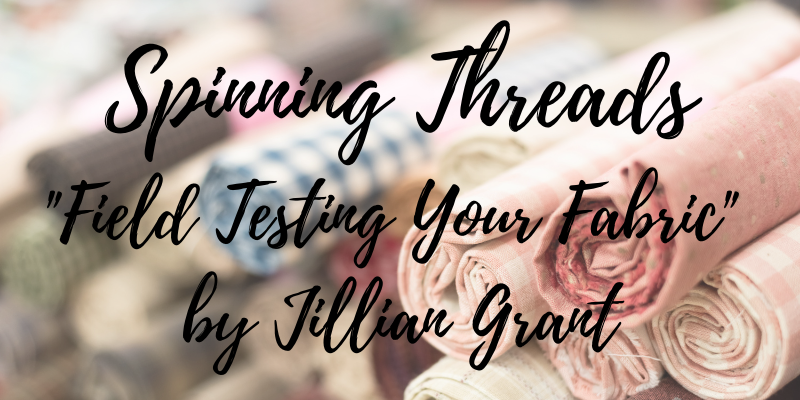Field Check for Quality
We’ve all heard the comments, “All fabric is the same,” “fabric is fabric,” and “some companies just charge more!” Some of us have even made those comments—including me. In fabric none of these statements are valid! The quality of one fabric is not the quality of another. Fabric has different weights, weaves and manufacturing processes. The cost of fabric is directly related to thread count, the raw material and the manufacturer’s process.
So, how does a quilter choose the right fabric? One way is to conduct a field check for quality. It may sound complicated but it is quite easy. You may get a few looks from fellow shoppers and clerks but do not panic! Others may be curious and ask questions giving you the opportunity to provide an education.
The Crumple and Wrinkle
The first field test on fabric should be to take a corner of the fabric you are looking at and crumple a bit in your hand. Hold it there for about 15 seconds then release the fabric. Does the fabric stay hopelessly crumpled or does it slowly regain its shape with minimal wrinkling? This is important as a good quality fabric should retain its original shape after being crumpled. If it remains a wrinkled mess in the yardage then walk away.
The Sniff Test
Yes, you read this right…the sniff test. Hold the fabric to your nose and inhale. Does the fabric have a distinct or strong chemical odor? This signals that the fabric has been chemically treated with stabilizers or sizing to make it appear heavier and more stable. If you smell heavy chemicals beware. Once you wash this fabric it will possibly go limp. To field test a “smelly” fabric grab a corner and place a hand on each side of the fabric and rub it with a rapid scrubbing motion between both hands. If the fabric loses its luster and stiffness once smoothed back out it is a poor-quality fabric.
The Rub
Know your thread count—it matters. You can field test for thread count since this is not generally listed on the bolt end. Simply place a spot of the fabric you are considering between your thumb and index finger and rub the two back and forth together. Now check the spot where you rubbed. Do the fabric fibers appear to be separating? Do the fabric fibers appear to be twisted or rubbed thin? If you answer “yes,” then the fabric is probably a low thread count and would not make the cut as a good quality quilt fabric.
The Wrong Side
Open the fabric you are considering for purchase just enough to look at the grain running both lengthwise and crosswise. Do the lengthwise threads appear to be running from one edge to the other in a relatively straight line? Do the crosswise threads that run up and down appear to be running straight? This will tell if the fabric is “on grain” or not. Also, look at the selvages. The threads should be running parallel to the selvage. A good quality fabric will have the threads at perfect right angles. If the fabric is “off-grain” and this can be spotted on the wrong side of the fabric, then the fabric is not a good candidate to produce a top-quality quilt.
Ghosting or Off-Registry
Unroll at least half a yard and look at the image. Do the images of the print appear to be crisp and aligned? If you see “ghosting” or where you can see a shadow slightly away from the print image. This means the printing process was not within the correct registry. A good manufacturer would make sure that all images in a print are perfectly aligned. Often a company will sell goods that are out of registry as seconds or thirds to a company that will then offer them at discounts to fabric merchants.
Seconds and Thirds
It is okay to ask a merchant if they have any second or third quality fabrics and if so where they are located in the store. You can then avoid that area. If they tell you they do and they are “mixed in” then your field test will be very vital to your purchase. Why would you want to pay the price for quality goods when there is a chance you are not getting what you pay for?
What About Internet Purchases
Go ahead and send a message to your seller and ask if they are offering first, second or third quality fabrics. Sometimes internet discounters are selling fabrics that are of lesser quality or fabric goods that entered the market in previous years. That is good if they are still first quality. Typically, those offering well-known manufacturer’s yard goods will not be afraid of answering questions. There is a lot of value to buying online as the discounts can be great since the seller might not have a lot of overhead. Make sure they have a good return policy. If you get merchandise and do a field test and the fabric fails, send it back for a refund and let them know why.
The Results of a Field Check for Quality
Checking your potential fabric purchase by doing a field check may appear strange to other shoppers and clerks. Those who understand what it takes to create a quilt will also understand that the quality of the textile goods is the first step. Ignore the stares and giggle to yourself as you rub, smell, crumple and inspect the goods you are considering. Giggle even louder when you observe someone else doing the same. It has become like a secret society in which you hold membership. It is the club of knowing how to make quality decisions about the quilt fabric you are purchasing.

